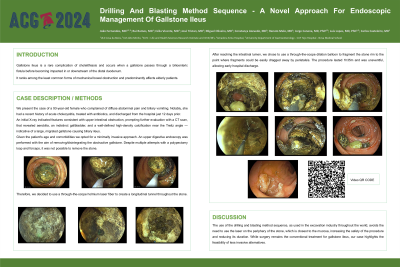Monday Poster Session
Category: Endoscopy Video Forum
P2171 - Drilling And Blasting Method Sequence - A Novel Approach For Endoscopic Management Of Gallstone Ileus
Monday, October 28, 2024
10:30 AM - 4:00 PM ET
Location: Exhibit Hall E

Has Audio

João Fernandes, MD
ULS Alto Minho; ICVS – Life and Health Sciences Research Institute and ICVS/3B’s; ULS Cova da Beira
Viseu, Viseu, Portugal
Presenting Author(s)
João Fernandes, MD1, Rui Ramos, MD2, Constança Azevedo, MD3, Renato Melo, MD3, Jorge Canena, MD, PhD4, Luís Lopes, MD, PhD, MBA5, Carlos Casteleiro, MD2
1ULS Alto Minho; ICVS – Life and Health Sciences Research Institute and ICVS/3B’s; ULS Cova da Beira, Viseu, Viseu, Portugal; 2ULS Cova da Beira, Covilhã, Castelo Branco, Portugal; 3Surgery Department - ULS Cova da Beira, Covilhã, Castelo Branco, Portugal; 4University Department of Gastroenterology - CUF Tejo Hospital - Nova Medical School; Amadora Sinta Hospital, Lisbon, Lisboa, Portugal; 5ULS Alto Minho; ICVS – Life and Health Sciences Research Institute and ICVS/3B’s, Viana do Castelo, Viana do Castelo, Portugal
Introduction: Gallstone ileus is a rare complication of cholelithiasis and occurs when a gallstone passes through a bilioenteric fistula before becoming impacted in or downstream of the distal duodenum. It ranks among the least common forms of mechanical bowel obstruction and predominantly affects elderly patients.
Case Description/Methods: We present the case of a 93-year-old woman who complained of diffuse abdominal pain and biliary vomiting. Notably, she had a recent history of acute cholecystitis, treated with antibiotics, and discharged from the hospital just 12 days prior. An initial X-ray indicated features consistent with upper intestinal obstruction, prompting further evaluation with a CT scan, that revealed aerobilia, an indistinct gallbladder, and a well-defined high-density calcification near the Treitz angle — indicative of a large, migrated gallstone causing biliary ileus. Given the patient's age and comorbidities we opted for a minimally invasive approach. An upper digestive endoscopy was performed with the aim of removing/disintegrating the obstructive gallstone. Despite multiple attempts with a polypectomy loop and forceps, it was not possible to remove the stone. Therefore, we decided to use a through-the-scope holmium laser fiber to create a longitudinal tunnel throughout the stone. After reaching the intestinal lumen, we chose to use a through-the-scope dilation balloon to fragment the stone rim to the point where fragments could be easily dragged away by peristalsis. The procedure lasted 1h35m and was uneventful, allowing early hospital discharge.
Discussion: The use of the drilling and blasting method sequence, as used in the excavation industry throughout the world, avoids the need to use the laser on the periphery of the stone, which is closest to the mucosa, increasing the safety of the procedure and reducing its duration. While surgery remains the conventional treatment for gallstone ileus, our case highlights the feasibility of less invasive alternatives.
Disclosures:
João Fernandes, MD1, Rui Ramos, MD2, Constança Azevedo, MD3, Renato Melo, MD3, Jorge Canena, MD, PhD4, Luís Lopes, MD, PhD, MBA5, Carlos Casteleiro, MD2. P2171 - Drilling And Blasting Method Sequence - A Novel Approach For Endoscopic Management Of Gallstone Ileus, ACG 2024 Annual Scientific Meeting Abstracts. Philadelphia, PA: American College of Gastroenterology.
1ULS Alto Minho; ICVS – Life and Health Sciences Research Institute and ICVS/3B’s; ULS Cova da Beira, Viseu, Viseu, Portugal; 2ULS Cova da Beira, Covilhã, Castelo Branco, Portugal; 3Surgery Department - ULS Cova da Beira, Covilhã, Castelo Branco, Portugal; 4University Department of Gastroenterology - CUF Tejo Hospital - Nova Medical School; Amadora Sinta Hospital, Lisbon, Lisboa, Portugal; 5ULS Alto Minho; ICVS – Life and Health Sciences Research Institute and ICVS/3B’s, Viana do Castelo, Viana do Castelo, Portugal
Introduction: Gallstone ileus is a rare complication of cholelithiasis and occurs when a gallstone passes through a bilioenteric fistula before becoming impacted in or downstream of the distal duodenum. It ranks among the least common forms of mechanical bowel obstruction and predominantly affects elderly patients.
Case Description/Methods: We present the case of a 93-year-old woman who complained of diffuse abdominal pain and biliary vomiting. Notably, she had a recent history of acute cholecystitis, treated with antibiotics, and discharged from the hospital just 12 days prior. An initial X-ray indicated features consistent with upper intestinal obstruction, prompting further evaluation with a CT scan, that revealed aerobilia, an indistinct gallbladder, and a well-defined high-density calcification near the Treitz angle — indicative of a large, migrated gallstone causing biliary ileus. Given the patient's age and comorbidities we opted for a minimally invasive approach. An upper digestive endoscopy was performed with the aim of removing/disintegrating the obstructive gallstone. Despite multiple attempts with a polypectomy loop and forceps, it was not possible to remove the stone. Therefore, we decided to use a through-the-scope holmium laser fiber to create a longitudinal tunnel throughout the stone. After reaching the intestinal lumen, we chose to use a through-the-scope dilation balloon to fragment the stone rim to the point where fragments could be easily dragged away by peristalsis. The procedure lasted 1h35m and was uneventful, allowing early hospital discharge.
Discussion: The use of the drilling and blasting method sequence, as used in the excavation industry throughout the world, avoids the need to use the laser on the periphery of the stone, which is closest to the mucosa, increasing the safety of the procedure and reducing its duration. While surgery remains the conventional treatment for gallstone ileus, our case highlights the feasibility of less invasive alternatives.
Disclosures:
João Fernandes indicated no relevant financial relationships.
Rui Ramos indicated no relevant financial relationships.
Constança Azevedo indicated no relevant financial relationships.
Renato Melo indicated no relevant financial relationships.
Jorge Canena indicated no relevant financial relationships.
Luís Lopes indicated no relevant financial relationships.
Carlos Casteleiro indicated no relevant financial relationships.
João Fernandes, MD1, Rui Ramos, MD2, Constança Azevedo, MD3, Renato Melo, MD3, Jorge Canena, MD, PhD4, Luís Lopes, MD, PhD, MBA5, Carlos Casteleiro, MD2. P2171 - Drilling And Blasting Method Sequence - A Novel Approach For Endoscopic Management Of Gallstone Ileus, ACG 2024 Annual Scientific Meeting Abstracts. Philadelphia, PA: American College of Gastroenterology.
